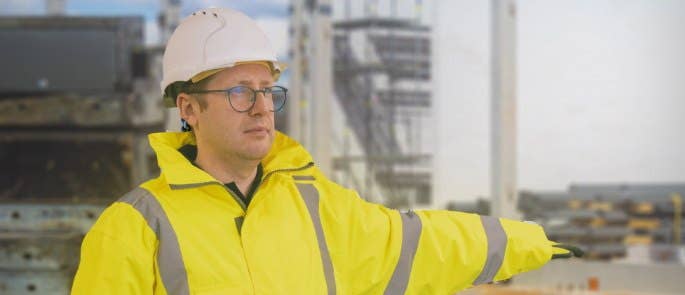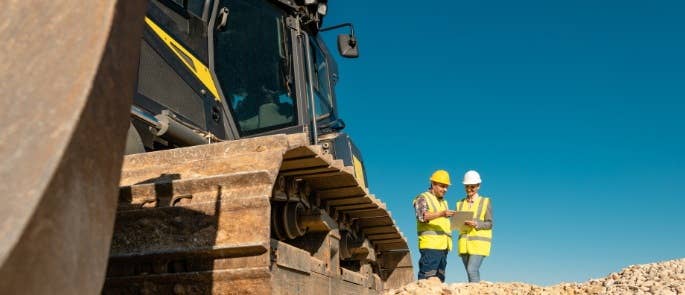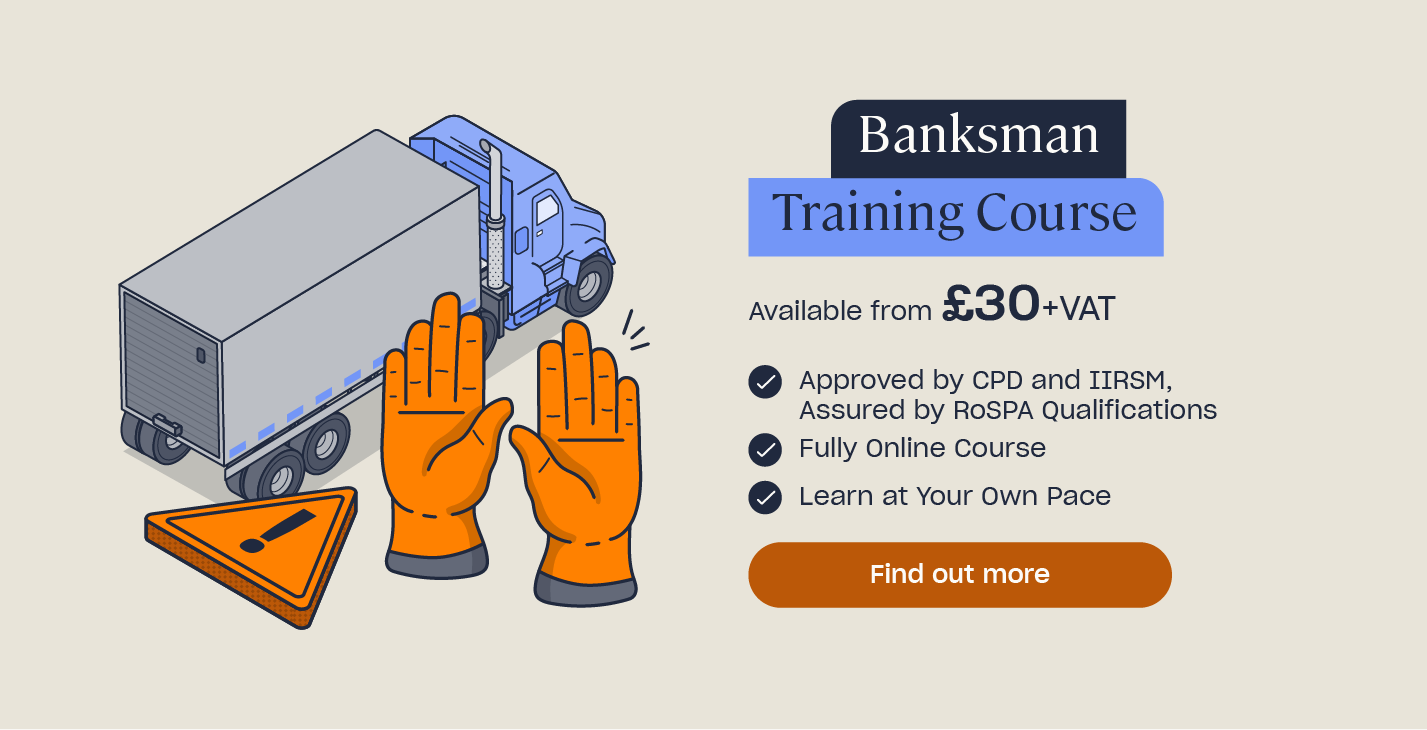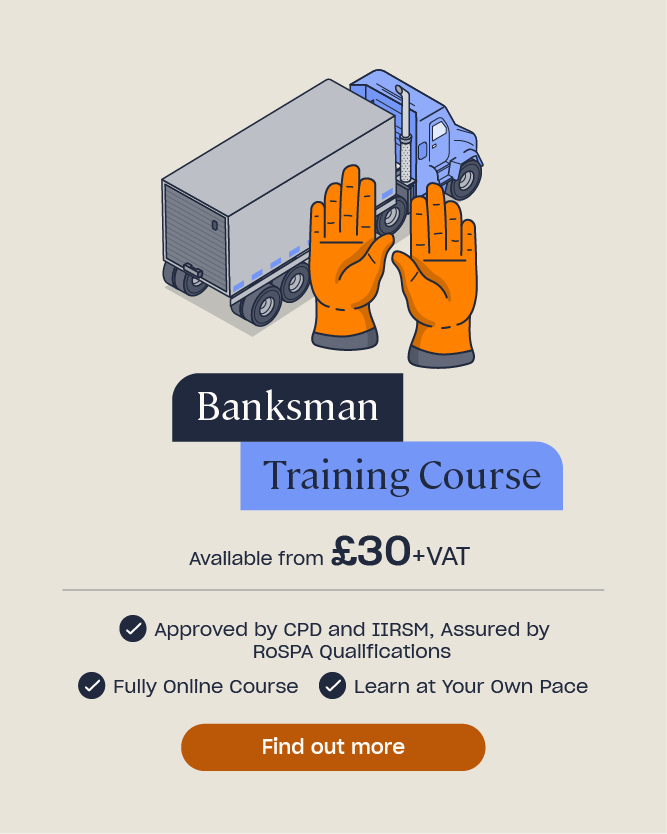What is a Banksman? Duties and Responsibilities
Vehicle and mobile plant operations for work activities can pose serious risks. In fact, there are unfortunately many accidents involving vehicles every year. Statistics from the Health and Safety Executive state that over 5,000 accidents occur annually involving workplace transport. Furthermore, reversing operations cause around a quarter of all fatal accidents each year.
It’s therefore vital that employers put in place sufficient controls for reducing the risks. Banksmen may be one of these controls that the risk assessment identifies as necessary. A properly-trained banksman will help to ensure that operations can run as safely as possible, so accidents are prevented.
In this article, we will explain what a banksman is, what a banksman’s duties and responsibilities are, and how to become a banksman who is competent to fulfil the role.
What is a Banksman?
A banksman is a trained and competent person who helps to ensure work activities involving vehicles and mobile plant are carried out safely. They form part of the safe working practices where other measures do not sufficiently control the risks posed by vehicles and mobile plant manoeuvres.

This means that duty holders (employers, self-employed people, and those who own or manage the premises) must consider other control measures first before a banksman. For example, redesigning the layout of the traffic routes to reduce risks. If risks still remain, the risk assessment may identify that the use of a banksman will help further reduce them to an acceptable level.
A key part of a banksman’s role is directing vehicles and mobile plant, where the driver or operator needs assistance to safely move or manoeuvre.
For example, drivers and operators may need assistance because:
- Movement or visibility is difficult or limited in restricted areas.
- Other means do not sufficiently control reversing risks.
- The area is unfamiliar (such as when working in new parts of forestry).
Banksmen help with vehicle operations in many types of industries and for a range of work activities, such as those:
- In fixed sites, e.g. factories, warehouses, and construction sites.
- In open air locations, e.g. public roads and open spaces such as forestry and agriculture.
A banksman’s overall duties and responsibilities are generally the same across each industry and type of operation that they help to guide. However, the specific ways in which they fulfil these and the specific on-site training required will differ between workplaces. This is because the work areas and activities will vary. We’ll cover all of this throughout the rest of the article.
What’s the Difference Between a Traffic Marshal and Banksman?
In the context of guiding vehicles and mobile plant operations for work, there is no difference between the terms traffic marshal and banksman. Traffic marshal is becoming increasingly used for this role, but banksman is also still widely recognised. This is why you will see both names referred to for this role.

Note that the role being referred to in this article is that of guiding vehicles and mobile plant used as part of work activities. There will be instances of these using public roads as temporary workplaces – such as during deliveries or road works. However, traffic marshal and banksman does not refer to roles that involve guiding public traffic on public roads.
What’s the Difference Between a Banksman and a Slinger Signaller?
A slinger signaller helps with guiding lifting and lowering operations, e.g. those that a crane carries out. Banksmen do not assist with these types of operations. Slinger signallers must receive formal training in how to safely provide assistance, and this is beyond the scope of a banksman’s role.
What Are a Banksman’s Duties and Responsibilities?
As mentioned earlier, a banksman’s role is to help ensure the safety of vehicle and mobile plant operations. To achieve this, they have a number of duties and responsibilities.
The key duties and responsibilities of a banksman usually include:
- Guiding drivers and operators of vehicles and mobile plant, where they need assistance during work operations. The banksman must guide them from a safe location, where they can always see the vehicle and where the driver or operator can always see the banksman. They must both agree that the driver will immediately stop the manoeuvre if they lose sight of the banksman.
- Helping to uphold the control measures for the work activities and environment. This requires having a good understanding of the risk assessment. They must know what controls the duty holder has put in place for sufficiently reducing the risks posed by the work area and operations. For example, understanding the layout and use of vehicle and pedestrian routes, obstructions in the area, visibility limitations of vehicles and mobile plant, speed limits, and more.
- Utilising their understanding of the risk assessment to identify if it is or isn’t safe to proceed with an operation, and to report any issues.
- Adhering to the training and preparation that they and the driver will receive for operations. This will ensure the banksman and driver both follow the necessary systems of work and are coordinated during the manoeuvre.
- Using an agreed and clear system of signalling to direct the driver or operator. The Health and Safety (Signs and Signals) Regulations 1996 set out the hand and verbal signals that banksmen commonly use. They can use a different system of signalling if they wish, provided that this is agreed between the banksman and driver. In some circumstances, the banksman might use verbal signals instead of hand signals. For example, when very large vehicles or mobile plant are involved in the operation.
- Keeping the area free from others while operations are underway, such as workers and pedestrians.

Part of a banksman’s duties and responsibilities may also involve contributing to the risk assessment, where they have relevant experience.
It’s good practice for employers to ask them for verbal input in such cases. Note, however, that the overall legal duty to carry out a risk assessment and implement controls for vehicles and mobile plant rests with the employer, not banksmen.
How to Become a Banksman
According to Go Construct, there are many ways to become a banksman, depending on the route you want to take and what suits you. For example, you could take an apprenticeship or college course relating to plant operations and/or the relevant work vehicles and industry. This will help you to gain a good foundation of knowledge. Site experience will be highly valuable, such as from work experience or apprenticeships.
All of this will put you in a strong position to apply for a banksman role, either externally or internally. Note, though, that you will then need further training relating to the specific site’s activities and environment. We’ll explain this shortly.
Is There a Banksman Qualification?
There is no one specific banksman qualification that you need to take. However, as discussed above, there are many routes to becoming equipped for the role of a banksman. Certain qualifications may assist you, like a college course, T-Levels, or training for gaining a relevant CSCS card, depending on the industry in which you’re looking to be a banksman. But these courses alone do not qualify you to be a banksman.
To be qualified or, more accurately, competent to fulfil the role, you need to have the necessary skills, knowledge, and experience. These will come from a range of areas.
Banksman Skills, Knowledge, and Experience
A combination of suitable skills, knowledge, and experience are necessary to be a competent banksman. You will most likely gain these from numerous areas, including via specific training from the business for which you’re wanting to be a banksman.
It’s vital for banksmen to receive training from their employer in relation to the specific control measures that are in place where they work, as every work site is different.

All banksmen who are new to a business or are in a new location must be familiarised with the new work activities and locations in which they will work, and the vehicles and mobile plant they’ll work with. This usually means a combination of formal training and being under the supervision of a trained and experienced banksman, until they have completed their training.
Job-specific training for banksmen will usually cover:
- General information about the location, such as traffic and pedestrian route layouts.
- Special conditions of the location, such as overhead pipes, cables, or restricted access.
- Information about speed limits, parking and loading areas, and driving procedures.
- The arrangements for supervision of the work location and who is overall in charge of the work in progress.
- The vehicles and mobile plant that are used on the site.
- Additional visibility aids, their use, and their limitations. For example, the use of large mirrors or reversing alarms.
- When and how to report risks or accidents.
Note that this list is not exhaustive, as it depends on the specific work activities and environment.
You may also need further training in certain aspects of your role that are not site-specific, such as:
- The relevant legislation relating to work vehicles and mobile plant safety. This will help you understand what your employer must do for everyone’s health and safety, and the importance of following and supporting health and safety controls.
- General information about the safe management of vehicles and mobile plant. This will help you to recognise the hazards and risks posed by vehicle and mobile plant operations, understand how to help uphold the control measures in place at your site, and contribute to the risk assessment where requested.
- How to safely and effectively use the nine general hand signals that banksmen commonly use, as set out by the Health and Safety (Signs and Signals) Regulations 1996.
As this training is not site-specific, it could be delivered on site or off site. For example, via an online banksman training course.
In summary, all of the training and experience you gain from various routes can help you to become prepared and competent for the role of a banksman.

Looking at past or current job adverts for banksman roles can help give you more of an idea of what businesses are after. You can then research into the opportunities near you, like apprenticeships or courses, that align with this and go from there.
A banksman is an important role for helping to ensure safe work vehicle and mobile plant operations. The use of a banksman will be considered where other controls have not sufficiently reduced the risks. It’s vital that banksmen are competent for their role, and there are many routes you can take to gain the necessary skills, knowledge, and experience.
Importantly, however, banksmen must receive training for the specific work activities and environment in which they’re going to guide drivers and operators. This will be provided on the job. Further training in the safe management of work vehicles and mobile plant, as well as how to use the common hand signals to guide drivers, will also help form part of your overall preparation for the role. All of this will help you become competent to help reduce the risks of vehicle and mobile plant operations. In turn, you’ll help to ensure everyone involved in the work activity and anyone nearby is safe.
What to Read Next:
- What is Effective Communication in Construction
- How to Become a Construction Worker
- Guidance on the PPE at Work Regulations: Responsibilities and Changes
- Crane Safety Hazards and Control Measures
- Warehouse Safety Quiz
- How to Find the Right Career for Me
- Banksman Training Course







